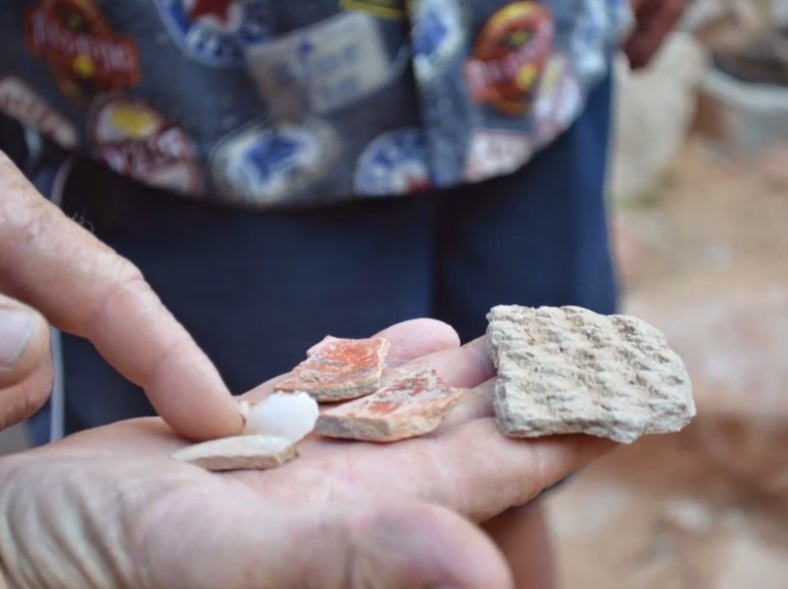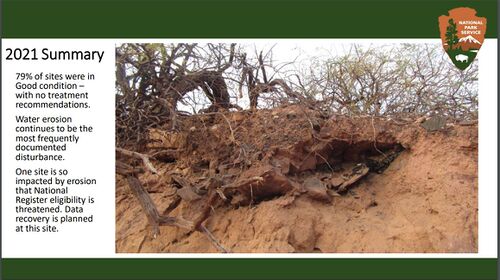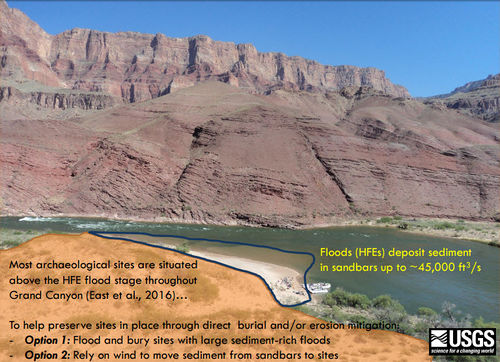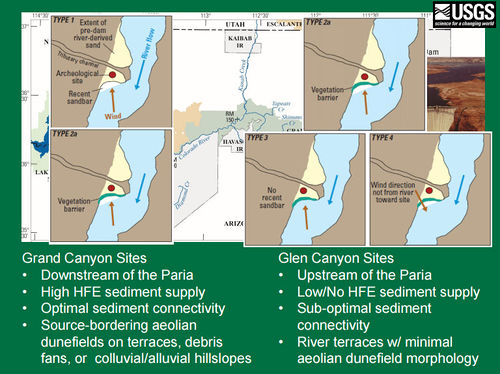Difference between revisions of "CULTURAL"
Cellsworth (Talk | contribs) |
Cellsworth (Talk | contribs) |
||
| (118 intermediate revisions by the same user not shown) | |||
| Line 1: | Line 1: | ||
| − | |||
| − | |||
| − | |||
| − | |||
| − | |||
__NOTOC__ __NOEDITSECTION__ | __NOTOC__ __NOEDITSECTION__ | ||
<!-- | <!-- | ||
| Line 21: | Line 16: | ||
</tr> | </tr> | ||
</table> | </table> | ||
| − | [[Image: | + | |
| + | [[Image:DSC 0867.JPG|center|300px]] <br> | ||
| + | |||
| + | [[Image:Shards of rock and pottery.jpg|center|300px]] | ||
| + | |||
<!-- | <!-- | ||
------------Portal list on righthand side----------> | ------------Portal list on righthand side----------> | ||
|style="width:60%; font-size:120%;"| | |style="width:60%; font-size:120%;"| | ||
| − | The lower reaches of Glen Canyon and the river corridor through Grand Canyon National Park, Arizona, have been used by humans for at least 13,000 years. Today, at least nine contemporary Native American Tribes claim traditional cultural ties to this area. Grand Canyon National Park contains more than | + | |
| + | =='''Cultural and Archaeological Resources'''== | ||
| + | The lower reaches of Glen Canyon and the river corridor through Grand Canyon National Park, Arizona, have been used by humans for at least 13,000 years. Today, at least nine contemporary Native American Tribes claim traditional cultural ties to this area. Grand Canyon National Park contains more than 4,000 documented prehistoric and historic sites, and about 420 of these sites are located in proximity to the Colorado River. The lower reaches of Glen Canyon contain an additional 55 sites. | ||
| + | |||
| + | In addition to archaeological sites, cultural resources along the Colorado River corridor include historic structures and other types of historic properties, as well as biological and physical resources that are of traditional cultural importance to Native American peoples such as springs, unique landforms, mineral deposits, native plant concentrations, and various animal species. | ||
| + | |||
| + | ==[http://gcdamp.com/index.php?title=Long-term_Experimental_and_Management_Plan_(LTEMP) '''LTEMP Resource Goal for Archaeological and Cultural Resources''']== | ||
| + | Maintain the integrity of potentially affected NRHP-eligible or listed historic properties in place, where possible, with preservation methods employed on a site-specific basis. | ||
| + | |||
| + | ==[http://gcdamp.com/index.php?title=Portal:Desired_Future_Conditions_-DFCs '''Desired Future Condition for Cultural Resources''']== | ||
| + | '''Prehistoric Archaeological Sites and Historic Sites:'''<br> | ||
| + | To the extent feasible, maintain significance and integrity through preservation in place.<br> | ||
| + | • If preservation in place is not feasible or reasonable, then implementation of appropriate preservation treatments will be implemented to ensure reduction or elimination of threats consistent with NPS management policies, tribal traditional values and historic preservation law.<br> | ||
| + | • Public access to historic properties on tribal lands is managed by the respective tribes. On lands administered by the NPS, access to some sites for users of the river corridor is maintained as long as integrity of the sites in not compromised.<br> | ||
|}<!-- | |}<!-- | ||
| Line 32: | Line 44: | ||
----------Strapline immediately below banner----------> | ----------Strapline immediately below banner----------> | ||
{| style="width:100%; height:50px" border=1px solid #ccc; background:#cedff2 | {| style="width:100%; height:50px" border=1px solid #ccc; background:#cedff2 | ||
| − | ! style="width=33%; background:#cedff2;" | [[ | + | ! style="width=33%; background:#cedff2;" | [[Tribal Ecological Knowledge]] <br> |
! style="width=33%; background:#cedff2;" | [[GCDAMP- Cultural Resources- Library|Cultural Resources Library]] <br> | ! style="width=33%; background:#cedff2;" | [[GCDAMP- Cultural Resources- Library|Cultural Resources Library]] <br> | ||
| − | ! style="width=33%; background:#cedff2;" | [ | + | ! style="width=33%; background:#cedff2;" | [http://gcdamp.com/index.php?title=Portal:GCDAMP_Tribal_Perspectives Tribal Perspectives]<br> |
|} | |} | ||
| Line 41: | Line 53: | ||
{|width="100%" cellpadding="2" cellspacing="5" style="vertical-align:top; background:#f5faff;" | {|width="100%" cellpadding="2" cellspacing="5" style="vertical-align:top; background:#f5faff;" | ||
! <h2 style="margin:0; background:#cedff2; font-size:120%; font-weight:bold; border:1px solid #a3bfb1; text-align:left; color:#000; padding:0.2em 0.4em;">Updates</h2> | ! <h2 style="margin:0; background:#cedff2; font-size:120%; font-weight:bold; border:1px solid #a3bfb1; text-align:left; color:#000; padding:0.2em 0.4em;">Updates</h2> | ||
| − | [[File: | + | |
| − | [[File: | + | [[File:2021 DisturbanceType.JPG|center|500px]] [https://www.usbr.gov/uc/progact/amp/twg/2022-01-13-twg-meeting/20220113-AnnualReportingMeeting-2021LTEMPArchaeologicalSiteSection106Monitoring-508-UCRO.pdf https://www.usbr.gov/uc/progact/amp/twg/2022-01-13-twg-meeting/20220113-AnnualReportingMeeting-2021LTEMPArchaeologicalSiteSection106Monitoring-508-UCRO.pdf] <br> |
| + | |||
| + | [[File:2021 Summary.JPG|center|500px]] [https://www.usbr.gov/uc/progact/amp/twg/2022-01-13-twg-meeting/20220113-AnnualReportingMeeting-2021LTEMPArchaeologicalSiteSection106Monitoring-508-UCRO.pdf https://www.usbr.gov/uc/progact/amp/twg/2022-01-13-twg-meeting/20220113-AnnualReportingMeeting-2021LTEMPArchaeologicalSiteSection106Monitoring-508-UCRO.pdf] <br> | ||
| + | |||
| + | [[File:AeolianOptions.jpg|center|500px]] [https://www.usbr.gov/uc/rm/amp/twg/mtgs/17jan26/AR5_Sankey.pdf https://www.usbr.gov/uc/rm/amp/twg/mtgs/17jan26/AR5_Sankey.pdf] <br> | ||
| + | |||
| + | [[File:AeolianTypes.jpg|center|500px]] [https://www.usbr.gov/uc/rm/amp/twg/mtgs/17jan26/AR5_Sankey.pdf https://www.usbr.gov/uc/rm/amp/twg/mtgs/17jan26/AR5_Sankey.pdf] <br> | ||
|} | |} | ||
| Line 52: | Line 70: | ||
|class="MainPageBG" style="width:45%; border:1px solid #cedff2; background:#f5faff; vertical-align:top;"| | |class="MainPageBG" style="width:45%; border:1px solid #cedff2; background:#f5faff; vertical-align:top;"| | ||
{| width="100%" cellpadding="2" cellspacing="5" style="vertical-align:top; background:#f5faff;" | {| width="100%" cellpadding="2" cellspacing="5" style="vertical-align:top; background:#f5faff;" | ||
| − | ! <h2 style="margin:0; background:#cedff2; font-size:120%; font-weight:bold; border:1px solid #a3b0bf; text-align:left; color:#000; padding:0.2em 0.4em;"> | + | ! <h2 style="margin:0; background:#cedff2; font-size:120%; font-weight:bold; border:1px solid #a3b0bf; text-align:left; color:#000; padding:0.2em 0.4em;">Information and Links</h2> |
|- | |- | ||
|style="color:#000;"| | |style="color:#000;"| | ||
| − | + | *[http://gcdamp.com/index.php?title=Portal:GCDAMP_Knowlege_Assessments GCMRC Annual Reports page] | |
| − | * [[ | + | *[https://www.nps.gov/grca/learn/management/upload/CRMPIF_s.pdf 2006 Colorado River Management Plan] |
| − | * [[Media: | + | *[https://www.nps.gov/grca/learn/historyculture/preservation.htm Grand Canyon National Park Archeological Resources page] |
| − | * [[Media: | + | *[https://www.nps.gov/features/grca/001/archeology/index.html Grand Canyon River Archeology Virtual Tour] |
| − | * [ | + | *[http://www.gcmrc.gov/research_areas/cultural_resources/cultural_resources_default.aspx USGS-GCMRC Cultural Resources Link] |
| + | *[http://gcdamp.com/index.php?title=GCDAMP_CRAHG_Page Cultural Resources (CRAHG) AdHoc Group] | ||
| + | *[http://gcdamp.com/index.php?title=Tribal_Resources Tribal Resources Page] | ||
| + | *[[Media:2017 LTEMP Final PA.pdf| 2017 LTEMP Programmatic Agreement]] | ||
| + | *[[Media:2018 LTEMP HPP.pdf| 2018 LTEMP Historic Preservation Plan ]] | ||
| + | *[[Media:Draft GCMRC Monitoring Plan w Appendix.docx| Draft plan for monitoring effects of geomorphic processes at archaeological sites in Grand & Glen Canyon. 10/7/15]] | ||
| + | *[http://gcdamp.com/index.php?title=GCDAMP-_Over-Flights Over Flights Page] | ||
| − | + | |- | |
| − | + | ! <h2 style="margin:0; background:#cedff2; font-size:120%; font-weight:bold; border:1px solid #a3b0bf; text-align:left; color:#000; padding:0.2em 0.4em;"> Cultural Projects </h2> | |
| + | |- | ||
| + | |style="color:#000;"| | ||
| − | + | *[http://gcdamp.com/index.php?title=Aeolian_Sand_Transport Aeolian Sand Transport Project] | |
| − | * [ | + | |
| − | + | ||
| − | + | ||
| − | + | |- | |
| − | + | ! <h2 style="margin:0; background:#cedff2; font-size:120%; font-weight:bold; border:1px solid #a3b0bf; text-align:left; color:#000; padding:0.2em 0.4em;"> Stakeholder Questions </h2> | |
| + | |- | ||
| + | |style="color:#000;"| | ||
| + | |||
| + | *Does aeolian sand transport research support the use of anthropogenic sand bar building as a means to provide a source of aeolian sands to preserve and protect archaeological sites or would current stabilization measures carried out by the NPS be more likely to be successful, predictable, and immediate at protecting archaeological sites? | ||
| + | [[Media:Collins 2016 GCArchSitesAeolian.pdf| '''Collin et al. 2016:''' ]] | ||
| + | *Aeolian deposition was found at 4 of 13 sites (30%) where partial infilling occurred preventing further erosion. | ||
| + | *“Despite this promise for archaeological site preservation, our observations show that gully annealing can only occur under a specific set of conditions related to fluvial sand availability and wind transport direction.” | ||
|- | |- | ||
| Line 78: | Line 108: | ||
|- | |- | ||
|style="color:#000;"| | |style="color:#000;"| | ||
| + | |||
| + | '''2024''' | ||
| + | *[[Media:Tango ARM2024 Poster IPDS.pdf| River management influences on archaeological site preservation: Results of more than a decade of monitoring geomorphic change along the Colorado River]] | ||
| + | |||
| + | '''2023'''' | ||
| + | *[https://www.usbr.gov/uc/progact/amp/twg/2023-04-13-twg-meeting/20230413-Section106NationalHistoricPreservationAct-508-UCRO.pdf Section 106 of the National Historic Preservation Act] | ||
| + | *[https://www.usbr.gov/uc/progact/amp/twg/2023-01-26-twg-meeting/20230126-AnnualReportingMeeting-ArchaeologicalSitesErodingGrandCanyonOwingSixDecadesGle%20CanyonDamOperations-508-UCRO.pdf Archaeological Sites are Eroding in Grand Canyon Owing to Six Decades of Glen Canyon Dam Operations: Floods, Low Flows and Vegetation Management Can Help] | ||
| + | |||
| + | '''2022''' | ||
| + | *[https://www.usbr.gov/uc/progact/amp/amwg/2022-08-18-amwg-meeting/20220818-Nelson-LTEMP-PA2022Summary_508.pdf Glen Canyon’s LTEMP Annual Cultural PA Meeting 2022] | ||
| + | *[https://pubs.usgs.gov/of/2022/1097/ofr20221097.pdf Caster et al., 2022, Terrestrial lidar monitoring of the effects of Glen Canyon Dam operations on the geomorphic condition of archaeological sites in Grand Canyon National Park, 2010–2020] | ||
| + | *[https://www.usbr.gov/uc/progact/amp/amwg/2022-02-10-amwg-meeting/20220210-NPS-USGSArchaeologicalSiteMonitoringResearch-508-UCRO.pdf NPS and USGS Archaeological Site Monitoring and Research ] | ||
| + | *[https://www.usbr.gov/uc/progact/amp/twg/2022-01-13-twg-meeting/20220113-AnnualReportingMeeting-2021LTEMPArchaeologicalSiteSection106Monitoring-508-UCRO.pdf 2021 LTEMP Archaeological Site Section 106 Monitoring ] | ||
| + | *[https://www.usbr.gov/uc/progact/amp/twg/2022-01-13-twg-meeting/20220113-AnnualReportingMeeting-CulturalBenefitsActionOpportunityFramework-508-UCRO.pdf Cultural Benefits Action Opportunity Framework ] | ||
| + | |||
| + | '''2020''' | ||
| + | *[https://www.usbr.gov/uc/progact/amp/amwg/2020-02-12-amwg-meeting/20200212-GCMRCScienceUpdatesPart3-Presentation-508-UCRO.pdf GCMRC 2019 Annual Reporting Meeting Overview – Part 3 ] | ||
| + | |||
| + | '''2018''' | ||
| + | *[https://www.usbr.gov/uc/progact/amp/twg/2018-10-10-twg-meeting/Attach_03.pdf Historic Preservation Plan Update] | ||
'''2015''' | '''2015''' | ||
| − | *[https | + | *[https://www.usbr.gov/uc/progact/amp/twg/2015-01-20-twg-meeting/Attach_04.pdf Cultural Site Monitoring in Glen and Grand Canyons] |
| − | + | ||
| − | + | ||
| − | + | ||
| − | + | ||
| − | + | ||
'''2014''' | '''2014''' | ||
| − | *[ | + | *[https://www.usbr.gov/uc/progact/amp/twg/2014-01-30-twg-meeting/Attach_07.pdf Cultural Resources Ad Hoc Group Report ] |
| − | + | *[https://www.usbr.gov/uc/progact/amp/twg/2014-01-30-twg-meeting/AR_Fairley_Landscape-scale.pdf Landscape-scale management implications of cultural resource studies (Fairley)] | |
| − | + | ||
| − | *[ | + | |
| − | + | ||
'''2013''' | '''2013''' | ||
| − | *[ | + | *[https://www.usbr.gov/uc/progact/amp/twg/2013-01-24-twg-meeting/Attach_04.pdf Memorandum of Understanding Among the U.S. Department of Defense, U.S. Dept. of the Interior, U.S. Dept. of Agriculture, U.S Dept. of Energy, and the Advisory Council on Historic Preservation Regarding Interagency Coordination and Collaboration for the Protection of Indian Sacred Sites] |
| + | *[https://www.usbr.gov/uc/progact/amp/twg/2013-01-24-twg-meeting/22_Fairley.pdf Summary of 2012 Accomplishments for Cultural Monitoring R&D Project, New Knowledge Gained, and Future Research Directions for FY2013-14] | ||
| + | |||
| + | '''2012''' | ||
| + | *[https://www.usbr.gov/uc/progact/amp/amwg/2012-02-22-amwg-meeting/Attach_12.pdf AIF: Glen Canyon Dam National Historic Preservation Act (NHPA) Compliance Update] | ||
| + | *[https://www.gcmrc.gov/about/ka/KA%202%20-%202-1-12/AM%20Talks/Fairley%200845-0930%20Arch%20Site%20Context.pdf Arch Site Context] | ||
'''2011''' | '''2011''' | ||
| − | *[ | + | *[https://www.usbr.gov/uc/progact/amp/amwg/2011-08-24-amwg-meeting/Attach_07.pdf AIF: National Park Service Colorado River Resource Monitoring and Mitigation Report and PPT] |
| − | + | ||
| + | '''2010''' | ||
| + | *[https://www.usbr.gov/uc/progact/amp/twg/2010-11-15-twg-meeting/Attach_11b.pdf Update on the Cultural Monitoring Research and Development Project] | ||
| + | *[https://www.usbr.gov/uc/progact/amp/amwg/2010-08-24-amwg-meeting/Attach_15d.pdf GCMRC Cultural Program Update] | ||
| + | *[https://www.usbr.gov/uc/progact/amp/twg/2010-06-29-twg-meeting/Attach_12.pdf “Review of Geoarchaeological Investigation and an Archaeological Treatment Plan for 151 Sites in the Grand Canyon, Arizona” by the GCDAMP Science Advisors dated July 2009] | ||
| + | *[https://www.usbr.gov/uc/progact/amp/twg/2010-06-29-twg-meeting/Attach_04b.pdf USGS/GCMRC Cultural Program Updates] | ||
| + | *[https://www.usbr.gov/uc/progact/amp/amwg/2010-02-03-amwg-meeting/Attach_10.pdf AIF: Report on Cultural Program and PPT, and DOI-DOE Guidance on Tribal Consultation for the Glen Canyon Dam Adaptive Management Program Dated December 16, 2009] | ||
| + | '''2009''' | ||
| + | *[https://www.usbr.gov/uc/progact/amp/twg/2009-09-29-twg-meeting/Attach_09.pdf AIF: Treatment Plan Update and Geoarchaeology Project Update PPT] | ||
| + | *[https://www.usbr.gov/uc/progact/amp/amwg/2009-08-12-amwg-meeting/Attach_05g.pdf Report on the Cultural Monitoring Research and Development Project PPT] | ||
| + | *[https://www.usbr.gov/uc/progact/amp/twg/2009-06-22-twg-meeting/Attach_05b.pdf Letter from Martha Hahn (NPS) dated May 18, 2009, stating NPS "...would not approve FY07-11 Archeological Sites and Development Project"] | ||
| + | *[https://www.usbr.gov/uc/progact/amp/twg/2009-06-22-twg-meeting/Attach_05a.pdf Report on Current Status and Phase I Results of the Cultural Monitoring R&D Project PPT] | ||
| + | *[https://www.usbr.gov/uc/progact/amp/twg/2009-06-22-twg-meeting/Attach_07g.pdf Grand Canyon National Park Cultural Resources Program Annual Budget Estimate for Support of 106 Treatment Program] | ||
| + | *[https://www.usbr.gov/uc/progact/amp/amwg/2009-04-29-amwg-meeting/Attach_03a.pdf AIF: Grand Canyon Monitoring and Research Center (GCMRC) Update] | ||
| + | *[https://www.usbr.gov/uc/progact/amp/amwg/2009-04-29-amwg-meeting/Attach_03f.pdf Update on the Cultural Monitoring R&D Project PPT] | ||
| + | *[https://www.usbr.gov/uc/progact/amp/amwg/2009-04-29-amwg-meeting/Attach_14a.pdf AIF: Archaeological Sites Analysis with HEC-RAS Model] | ||
| + | *[https://www.usbr.gov/uc/progact/amp/amwg/2009-04-29-amwg-meeting/Attach_14b.pdf Analysis of Virtual Shorelines in Relation to Archaeological Sites in the Colorado River Ecosystem PPT] | ||
| + | *[https://www.usbr.gov/uc/progact/amp/amwg/2009-04-29-amwg-meeting/Attach_14c.pdf Archaeological Sites Analysis TWG Actions] | ||
| + | *[https://www.usbr.gov/uc/progact/amp/twg/2009-03-16-twg-meeting/Attach_05.pdf Grand Canyon Monitoring and Research Center updates by Program Managers] | ||
| + | *[https://www.usbr.gov/uc/progact/amp/twg/2009-03-16-twg-meeting/Attach_12a.pdf AIF: River Stage and Archaeological Sites] | ||
| + | *[https://www.usbr.gov/uc/progact/amp/twg/2009-03-16-twg-meeting/Attach_12b.pdf An Evaluation of Selected Erosional Factors on Grand Canyon Archaeological Sites (prepared by M. Berry)] | ||
| + | *[https://www.usbr.gov/uc/progact/amp/twg/2009-03-16-twg-meeting/Attach_12c.pdf Potential of Glen Canyon Releases to Inundate Cultural Sites in Grand Canyon National Park: A GIS Analysis Using Modeled Virtual Shorelines and Canyon-wide Topographic Data PPT (prepared by Hoda Sondossi)] | ||
| + | *[https://www.usbr.gov/uc/progact/amp/twg/2009-03-16-twg-meeting/Attach_12f.pdf Geoarchaeological investigations and an archaelogical treatment plan for 151 sites in Grand Canyon, Arizona] | ||
| + | *[https://www.usbr.gov/uc/progact/amp/twg/2009-03-16-twg-meeting/Attach_13.pdf Analysis of Virtual Shorelines in Relation to Archaeological Sites in the Colorado river Ecosystem PPT] | ||
|- | |- | ||
| − | ! <h2 style="margin:0; background:#cedff2; font-size:120%; font-weight:bold; border:1px solid #a3b0bf; text-align:left; color:#000; padding:0.2em 0.4em;"> | + | ! <h2 style="margin:0; background:#cedff2; font-size:120%; font-weight:bold; border:1px solid #a3b0bf; text-align:left; color:#000; padding:0.2em 0.4em;">Other Stuff</h2> |
|- | |- | ||
|style="color:#000;"| | |style="color:#000;"| | ||
| − | |||
| − | |||
| − | |||
|} | |} | ||
Latest revision as of 17:03, 5 February 2024
|
|
Cultural and Archaeological ResourcesThe lower reaches of Glen Canyon and the river corridor through Grand Canyon National Park, Arizona, have been used by humans for at least 13,000 years. Today, at least nine contemporary Native American Tribes claim traditional cultural ties to this area. Grand Canyon National Park contains more than 4,000 documented prehistoric and historic sites, and about 420 of these sites are located in proximity to the Colorado River. The lower reaches of Glen Canyon contain an additional 55 sites. In addition to archaeological sites, cultural resources along the Colorado River corridor include historic structures and other types of historic properties, as well as biological and physical resources that are of traditional cultural importance to Native American peoples such as springs, unique landforms, mineral deposits, native plant concentrations, and various animal species. LTEMP Resource Goal for Archaeological and Cultural ResourcesMaintain the integrity of potentially affected NRHP-eligible or listed historic properties in place, where possible, with preservation methods employed on a site-specific basis. Desired Future Condition for Cultural ResourcesPrehistoric Archaeological Sites and Historic Sites: |
| Tribal Ecological Knowledge |
Cultural Resources Library |
Tribal Perspectives |
|---|




